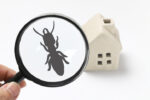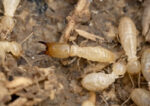
Protect Your Home: How to Keep Termites Out
Each year, over two million homes in the United States will be treated for a termite infestation. Termite damage in the United States costs homeowners more than $5 billion in property damage every year. South Florida homeowners are at higher risk than some other cooler parts of the US due to the hot and humid climate. Some experts say that with this year’s generous rainfall amounts and warmer than usual temperatures, termites are expected to be in abundance and hungry, looking for your home’s wood to devour.
Termites can go unnoticed, causing extensive damage
The tricky thing about termites lies in the fact that, more often than not, termites are not visible in your home until you find damage. Drywood termites live in the wood they infest, hollowing out the cellulose. Subterranean termites, more aggressive than drywood or dampwood termites, with larger colonies, build earthen tunnels into your home, through ground to wood contact but they actually live in massive nests in the soil outside your home. Formosan subterranean termites are capable of building nests in homes and buildings, damaging your walls, attic, ceiling and roof. Drywood termites, not needing soil contact to survive, can live in your walls, attic, roof and ceiling. Conehead termites, a new species to South Florida, live in live trees or shrubbery near your home, entering your home through earthen tubes.
Invasive subterranean termites do more significant damage in a short period of time
University of Florida researchers are currently on the lookout for a super breed hybrid species to emerge as, due to warmer temperatures, invasive Asian and Formosan subterranean termites are swarming at the same time, for the first time in South Florida. While cases of hybridization are rare, a super breed termite could grow twice as fast as their parents, with the potential for extensive damage to occur faster. Currently, Formosan termites can cause significant damage to a home in a couple of months, whereas native subterranean and drywood termites, with smaller colonies can take several years to cause significant damage.
Structural damage can threaten the stability of your home
Termite infestations, if left untreated can cause extensive damage. Roofs, ceilings, floors and walls can collapse if termites weaken your structural supports, including posts and beams, wall studs and floor or ceiling joists. Damage to hardwood floors can be a complicated repair job, as termites can damage your subflooring and floor supports. Damage to subflooring can cause laminate floors to blister and sag. Removing sections of laminate may be necessary to assess the damage to the subfloor and support joists, as well. Termite damage can also affect tile flooring, when moisture seeping into the subfloor allows termites to move among the tiles, causing tile adhesives to weaken. Buckled tile flooring, caused once again by termite damage to subflooring, can loosen even ceramic and porcelain tiles.
Termites can also cause damage to parts of your home you may not associate with termite activity
Termites eat anything containing cellulose, including sheetrock paper. Because ceilings are composed of sheetrock and wood, termites in your walls can gain access to your ceilings, especially drywood and Formosan termites. Usually, if you find termite damage in your ceiling, such as cracks and shifting boards, your wall supports have also been compromised by termites making their way to your ceilings. Termites in your attic can cause damage to your roof supports, eaves and fascia, causing moisture to leak into your home. Although we don’t think about termite damage in bathrooms, high humidity levels and the potential for leaky pipes and drains create an ideal environment for termites to thrive. Termite infestations going on behind ceramic tile walls and porcelain fixtures can be invisible, until the sink supports give way to termite damage or tiles fall off of walls or your bathtub’s support structure is damaged. Repairing bathtub supports can be challenging and expensive due to the complication of accessing infestations near plumbing and fixtures.
Be a proactive, responsible homeowner
In South Florida, where termites abound, proactive homeowners get a jump on protecting their homes and loved ones, by contacting a trusted pest control professional, such as Hulett Environmental Services to deal with any current infestations and to take advantage of our Annual Termite Protection that creates a barrier around your home to guard against termites and other pests. Hulett also offers a Million Dollar Subterranean Termite Damage Warranty that covers repairs up to a million dollars, should termites return. Utilizing environmentally responsible materials and methods, we treat any signs of termite activity with a non-repellent liquid, Termidor, sprayed directly into termite galleries that termite workers spread to their entire colonies, through contact, destroying the colony. Environmentally sensible bait stations can also be installed on your property to control subterranean termite activity. Recognizing the signs of termite activity can also help to detect termite activity before damage is done.
Signs of a termite infestation
- Discarded wings near windows indicate termites swarming indoors in search of mates. After young reproductives swarm as part of a mating ritual, new kings and queens look for a cozy place to set up shop and raise their young. Swarming indoors can indicate an existing colony.
- Piles of “frass,” the distinctive pellet-shaped excrement pushed out of nests by drywood termites.
- Mud tubes running from the ground to your foundation.
- Noticeable buckling and squeaking in flooring or flooring that looks water damaged can point to termite activity.
- Wood that sounds hollow when tapped or that is easily punctured with the point of a tool.
- Sagging ceilings and walls that look water damaged.
Contact Hulett today to schedule a free termite inspection. Select from many convenient time slots that work for your busy schedule to start receiving the termite protection every South Florida homeowner needs. Just call Hulett!




